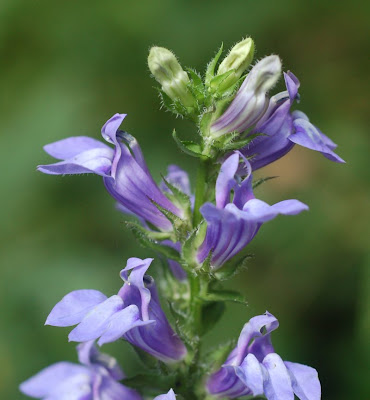
I found this Great Blue Lobelia plant growing in a tiny spring seep on the side of our ridge last week. It must have been the only moist place on our property, and I was quite surprised to find it. Lobelia siphilitca Linnaeus is a big, showy, moisture-loving plant common enough around the rivers and creeks here.
I've assembled some interesting Lobelia links. If you'll excuse me now, I'm going to join my cat outside in the rain. We are both startled and amazed by this business of water falling from the sky.
- Connecticut Botanical Society page for Great Blue Lobelia
- Missouri Plants page for Lobelia siphilitica L.
- USDA Plants Database page for Lobelia siphilitica L.
- Ladybird Johnson Wildflower Center Wildflowers Database entry for Great Blue Lobelia "The unfortunate species name, siphilitica, is based on the fact that it was a supposed cure for syphilis."
- Ethnobotany data from the USDA's National Plant Data Center
The Iroquois used the plant as a cough medicine. The Meskwaki ground up the roots of this plant and used it as an anti-divorce remedy. The mashed roots were secretly put into some common dish, which was eaten by both husband and wife. The Cherokee used a cold infusion of the roots of great blue lobelia and cardinal flower to treat nosebleed. A poultice of the crushed leaves of the plant was used for headache and a warm leaf infusion was good for colds.
- Alternative Nature Online Herbal lists the properties of Lobelia siphilitica:
Lobelia was a highly prized medicinal plant and used extensively by Native Americans. It was considered a panacea, being used for just about everything that ailed them. Once it was discovered by Europeans and taken back to England they also used it for many illnesses. Lobelia is still used today as an alternative medicine in many parts of the world. Medical research has found the plants constituents to be Piperidine alkaloids including Lobeline, and other carboxylic acids as well as isolobelanine, gum, resin, chlorophyl, fixed oil, lignin, salts of lime and potassium, with ferric oxide. Lobeline stimulates the respiratory center of the brain, producing stronger and deeper breathing, making it very useful in treating many respiratory complaints, such as asthma, chronic bronchitis, whooping cough, spasmodic croup, and pneumonia. While at the same time isolobelanine, relaxes the respiratory and neuro-muscular system and acts as a nervine and antispasmodic. It is a most useful systemic relaxant and a holistic combination of stimulation and relaxation. The seeds contain a much higher percentage of lobeline than the rest of the plant. The whole plant is used as an analgesic, cathartic, emetic, expectorant, diaphoretic, anti-asthmatic, stimulant, antispasmodic, narcotic, and sedative. Used to treat convulsive and inflammatory disorders such as epilepsy, hysterical convulsions, traumatic injuries, tetanus, sores and abscesses, colds and fevers, diphtheria and tonsilitis. When chewed it tastes similar to tobacco and produces effects like those of nicotine. It is used in some antismoking products. Also used for scorpion and snake bites and to induce nausea and vomiting. A poultice of the root has been applied in treating pleurisy, rheumatism, tennis elbow, whiplash injuries, boils, ulcers and hard to heal sores.

4 comments:
Do you use medicinal plants medicinally? One of my favorite sleep aids, when I'm seriously suffering from insomnia, includes lobelia, with hops and valerian. It stinks to high heaven, though, so I have to put it in tiny capsules.
I'm not macho enough to drink these medicinal concoctions in their tea infusion formats.
I always enjoy happening upon Great Blue Lobelia plants. The "underbelly" of the flowers always reminds me of a miniature vegetative version of the Blue Whale, a creature I've never met but would like to meet someday.
Then there is Lobelia inflata, a modest member of the genus which is easy to overlook. This species has medicinal uses as well.
Gorgeous photo
Reya, I've not had much luck with teas, although we've tried burdock root, yellow dock, yarrow, coltsfoot. If tasting bad is a measure of how good they are for you, then these are powerful medicines. Actually, my favorite herbal remedies are kitchen spices--especially ginger. I know some people around here who make their own St. John's Wort and black cohosh preparations (soaked in ethanol). And we use mullein leaves for skin irritations.
Larry, I'm more familiar with the more modest Lobelias. There's a community down the mountain from us called "Lobelia," and years ago it had a post office and a grocery store.
Thanks, Rick!
Post a Comment